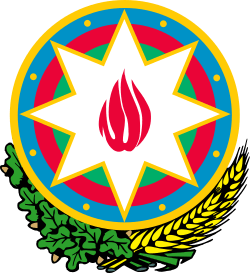Azerbaijani dances
Azerbaijani dances (Azerbaijani: Azərbaycan Rəqsləri) are traditional dances developed and performed by the Azerbaijani people of Azerbaijan and Iranian Azerbaijan. These dances are known for their quick tempo and the dancers' traditional clothing.[1]
| Music of Azerbaijan | |
|---|---|
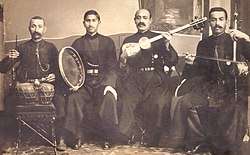 | |
| General topics | |
| Genres | |
| Specific forms | |
| Traditional music | |
| Subgenres | |
| Media and performance | |
| Music festivals | |
| Music media | Medeniyyet TV |
| Nationalistic and patriotic songs | |
| National anthem | March of Azerbaijan |
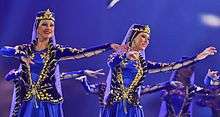
Female dance
.jpg)
Male dance
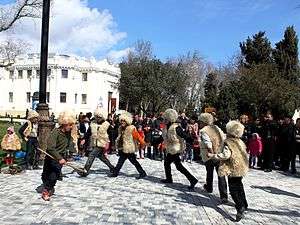
Khanchobany (dance) in Nowruz
Examples of dances in Azerbaijan
- Abayi (Azerbaijani: Abayı) is an Azerbaijani dance with its origins in the Shaki and Zaqatala regions of Azerbaijan. The name of the dance refers to the middle-aged people who typically perform this dance with exaggerated movements for comedic effect. The dance's slow-tempo song was written by Shaki composers. This dance is traditionally performed as a group but has evolved into a solo dance.[2]
- Agir Karadagi (Azerbaijani: Ağır Qaradağı, meaning "heavy Karadakhi") is dance song that originated in Karadakh. This slow dance is popular in Shaki and Zaqatala.
- Alcha Gulu (Azerbaijani: Alça gulu, meaning "plum flower") is an Azerbaijani-Indian dance created between 1910 and 1920 in the Kalva village of Shaki by Ali Karimov. This fast-paced dance is performed by women.
- Anzali (Azerbaijani: Ənzəli) is a traditional dance that was created approximately in 1880-1890 in Baku. This slow dance is typically performed by older people at the beginning of wedding ceremonies.
- Asma Kasma (Azerbaijani: Asma Kəsmə, meaning "hanging cutting") is one of the oldest Azerbaijani wedding dances. The song "Asma-Kasma" accompanies the procession of the bride to the bridegroom's home as women dance alongside the bride. This slow, slightly exaggerated dance features a number of jumps.
- Asta Karabagi (Azerbaijani: Asta Qarabağı, meaning "slow Karabakhi") is a dance from Karabakh. This slow dance has fixed movements.
- Avari (Azerbaijani: Avarı) originates from the Avari people who live in Azerbaijan. Over the course of the dance's three parts, the dancers' movements gradually accelerate until they reach the quick rhythm of the Lezginka music.
- Ay bari bakh (Azerbaijani: Ay bəri bax, meaning "look at me") is one of the oldest dances that is performed only by women.
- Banovsha (Azerbaijani: Bənövşə, meaning "Viola flower") represents how a violet grows from the ground, blooms, and fades.
- Birilyant (Azerbaijani: Birilyant, meaning "brilliant") has two varieties: one performed by men and the other by women. The men's fast-tempo dance was created in Baku in the years 1920-1922. The women's dance is slower and elegant with more melodic music.
- Ceyrani or Ceyran bala (Azerbaijani: ceyran, meaning "Gazelle", an Azeri given name for girls) is a dance, performed by both men and women, which symbolizes the gazelle's gracefulness and elegance.
- Chichekler, meaning "flowers" in Azeri, is an elegant dance that was created in 1910. This women's dance is typically performed in two different forms: slow and fast. The group of colorfully costumed dancers gathers together to collect flowers to display to the audience. The dancers form circles and triangles to the upbeat music. The dance also includes complex hand movements and spins.[3]
- Choban Regsi (from Persian: Choopan, meaning "shepherd's dance") is a men's dance typical to rural areas. This energetic dance symbolizes the cheerful spirit of the shepherd who brings his herd to the valley.
- Innabi (Azerbaijani: İnnabı, meaning "name of a fruit") is performed by one or two female dancers to exhibit a woman's airs and graces as well as coquetry.
- Gangi (Azerbaijani: Cəngi, meaning "related to war" (from Persian: Dgang جنگ, meaning "war")) is martial music that calls all people to unity, friendship, and invincibility.[4]
- Halay (Azerbaijani: Yalli) is a traditional dance that was first performed at a traditional celebration of fire where dancers would worship fire as a goddess. Halay begins slowly and finishes with quick, running-like steps. Historically, whoever didn't dance the halay correctly was fined by the chieftain, who would then make him sing a song or dance another dance.
- Lezginka (Azerbaijani: Ləzgi) is a national dance of Lezghins popular among many people in the Caucasus Mountains.
- Mirzayi (Azerbaijani: Mirzəyi) is traditionally played at wedding parties and performed by men and women with handkerchiefs in their hands.
- Nalbeki (Azerbaijani: Nəlbəki, meaning "saucer") is a women's dance performed with dance saucers.
- Ouch noumra, dourd noumra, besh noumra, alti noumra (Azerbaijani: 3 nümrə. 4 nümrə. 5 nümrə. 6 nümrə. - meaning "Number 3, Number 4, Number 5, Number 6") are famous dance melodies composed in the second half of the 1920s in Baku. Dance 3 and 5, which have slow tempos and doleful melodies, are performed by women. Dances 4 and 6 have a slightly faster tempo and are performed by both women and men.
- Tarakama (Azerbaijani: Tərəkəmə) is a dance of a tribespeople performed by both men and women with arms extended and heads up.
- Vagzali (Azerbaijani: Vağzalı) is a dance for when the bride departs from her family house to the house of the bridegroom.[5]
- Zorkhana (Persian: Zurkhaneh, meaning "house of strength") is a men's dance that symbolizes courage, bravery, and youthful enthusiasm.
- Gaitagi-(Azerbaijani: Qaytağı) is a rapid and dynamic dance.
- Heyvagulu (Azerbaijani: Heyvagülü) was choreographed by the Seygah mugham.
- Uzundara, meaning “a long gauge”, is a long dance performance. It was traditionally performed when the bride and bridegroom are on the road.
- Turajy (Azerbaijani:Turacı) is a women's dance that includes lyrics.
During Nowruz
Nowruz (meaning "a new day" in Persian, spelled as Novruz in Azerbaijani) is an ancient celebration of the Iranian New Year and spring and the renewal and fertility to come. Nowruz is observed on the day of vernal equinox in Iran and as far east as Tajikistan and as far west as the Kurdish regions of Turkey. Novruz in Azerbaijan is a family holiday that ends with festive public dancing and other entertainment of folk bands.
gollark: It's equating "tolerance" meaning being utterly okay with a thing and "tolerance" meaning not actively censoring it, roughly.
gollark: The paradox of tolerance is just equivocational beeoids regarding tolerance, though?
gollark: I'm trying to get a similar dataset for bees, since I can do the searchy bit.
gollark: It's a bot doing image *search*.
gollark: It's not AI-generated.
See also
- Turkish dance
- Iranian dance
References
- Azerbaijan - a part of Europe (2007-11-24). "Azerbaijan - a part of Europe". Azeriyoungsters.blogspot.com. Retrieved 2012-12-16.
- Azerbaijani Dance Archived May 29, 2009, at the Wayback Machine
- "Traditional Azeri Dance". Bangkokcompanies.com. Archived from the original on 2013-01-06. Retrieved 2012-12-16.
- National dances
- Swiss girls perform Azerbaijani dances Archived May 31, 2009, at the Wayback Machine
This article is issued from Wikipedia. The text is licensed under Creative Commons - Attribution - Sharealike. Additional terms may apply for the media files.
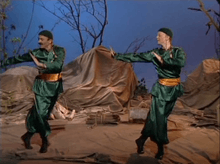
.jpg)
